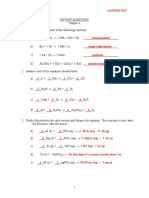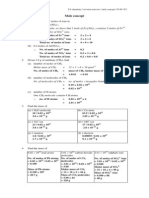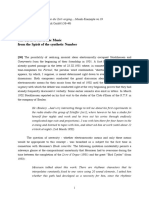Quiz 1A: Chemistry 123 Harwood/Fall 05
Quiz 1A: Chemistry 123 Harwood/Fall 05
Uploaded by
216435964Original Description:
Original Title
Copyright
Available Formats
Share this document
Did you find this document useful?
Is this content inappropriate?
Report this DocumentCopyright:
Available Formats
Quiz 1A: Chemistry 123 Harwood/Fall 05
Quiz 1A: Chemistry 123 Harwood/Fall 05
Uploaded by
216435964Copyright:
Available Formats
Chemistry 123 Quiz 1 Harwood/Fall 05
KEY
Quiz 1A
1. If you burn 1.959 g of Fex(CO)y and find 0.799 g of Fe2O3 and 2.200 g of CO2, what is the empirical
formula of Fex(CO) y? (3 pts)
(a) Fe(CO)4 ! 1 mol Fe2O 3 $ ! 2 mol Fe $ ! 55.8477 g $ ! 1 mol Fe $
mol Fe = ( 0.799 g Fe2O 3 ) # # & = 0.010008 mol Fe ' 1
" 159.6922 g &% #" 1 mol Fe2O 3 &% " 1 mol Fe % #" 55.847 g &%
(b) Fe2(CO)9
! 1 mol CO2 $ ! 1 mol C $ ! 12.011 g $ ! 1 mol C $
mol C = ( 2.200 g CO2 ) # # & = 0.04999 mol C ' 5
(c) Fe(CO)5 " 44.0098 g &% #" 1 mol CO2 &% " 1 mol C % #" 12.011 g &%
! 1 mol O $
(d) Fe(CO)6 mol O = [1.959 g - (0.5589 g + 0.6004 g)] # = 0.04998 mol O ' 5
" 15.9994 g &%
2. In an experiment, 1.056 g of a metal carbonate containing an unknown metal M was heated to give
the metal oxide and 0.376 g CO2. What is the identity of the metal M? (2 pts)
(a) M = Ni ! 1 mol CO2 $
mol CO2 = ( 0.376 g CO2 ) # = 0.008544 mol CO2
" 44.0098 g &%
(b) M = Cu
! 1 mol MCO 3 $
(c) M = Zn mol MCO 3 = ( 0.008544 g CO2 ) # = 0.008544 mol MCO 3
" 1 mol CO2 &%
(d) M = Ba 1.056 g
molar mass MCO 3 = = 123.602 g/mol
0.008544 mol
atomic mass of M = 123.602 g/mol - [12.011 + (3 x 15.994)] = 63.59 g/mol
– – –
3. A new element, lubine (Lb), has been discovered. It forms four oxoanions: LbO2 , LbO3 , LbO4 ,
–
LbO5 . Name the following compounds: (2 pts)
(a) NaLbO3 sodium lubite (b) NaLbO5 sodium perlubate
4. Identify the type of chemical reaction represented by the following equations. (3 pts)
(a) 3 H2 (g) + N2 (g) → 2 NH3 (g) combination
(b) AgNO3 (aq) + NaCl (aq) → NaNO3 (aq) + AgCl (s) exchange
(c) CaCO3 (s) → CaO (s) + CO2 (g) decomposition
Quiz 1B
1. Same as 1A
2. Same as 1A
– – –
3. A new element, lubine (Lb), has been discovered. It forms four oxoanions: LbO2 , LbO3 , LbO4 ,
–
LbO5 . Name the following compounds: (2 pts)
(a) NaLbO2 sodium hypolubite (b) NaLbO4 sodium lubate
4. Identify the type of chemical reaction represented by the following equations. (3 pts)
(a) P4O10 (s) + 6 H 2O (l) → 4 H3PO4 (l) combination
(b) 2 Al (s) + 3 H2SO4 (aq) → Al2(SO4)3 (s) + 3 H2 (g) displacement
(c) 2 Na (s) + 2 H2O (l)→ 2 NaOH (aq) + H2 (g) displacement
Chemistry 123 Quiz 1A Harwood/Fall 05
Quiz 1C
1. The complete reaction of 3.84 g of vanadium with 8.16 g of chlorine (Cl2) produces a compound with
the formula VxCly. What is the empirical formula of the compound? (3 pts)
(a) VCl ! 1 mol V $
mol V = ( 3.84 g V ) # = 0.07538 mol V ' 1
" 50.9415 g &%
(b) VCl2
! 1 mol Cl2 $ ! 2 mol Cl $
mol Cl = ( 8.16 g Cl2 ) # = 0.2302 mol Cl ' 3
(c) VCl3 " 70.906 g &% #" 1 mol Cl2 &%
(d) VCl4
(e) VCl5
2. In an experiment, 1.056 g of a metal carbonate containing an unknown metal M was heated to give
the metal oxide and 0.391 g CO2. What is the identity of the metal M? (2 pts)
(a) M = Ni ! 1 mol CO2 $
mol CO2 = ( 0.391 g CO2 ) # = 0.008884 mol CO2
" 44.0098 g &%
(b) M = Cu
! 1 mol MCO 3 $
(c) M = Zn mol MCO 3 = ( 0.008884 g CO2 ) # = 0.008884 mol MCO 3
" 1 mol CO2 &%
(d) M = Ba 1.056 g
molar mass MCO 3 = = 118.860 g/mol
0.008884 mol
atomic mass of M = 118.860 g/mol - [12.011 + (3 x 15.9994)] = 58.85 g/mol
– – –
3. A new element, lubine (Lb), has been discovered. It forms four oxoanions: LbO2 , LbO3 , LbO4 ,
–
LbO5 . Name the following compounds: (2 pts)
(a) Ca(LbO2)2 calcium hypolubite (b) Ca(LbO4)2 calcium lubate
4. Identify the type of chemical reaction represented by the following equations. (3 pts)
(a) 3 Fe (s) + 4 H2O (g) Fe3O4 (s) + 4 H2 (g) displacement
(b) 2 AgNO3 (aq) + BaCl2 (aq) → Ba(NO3)2 (aq) + 2 AgCl (s) exchange
(c) 2 KClO3 (s) 2 KCl (s) + 3 O2 (g) decomposition
Quiz 1D
1. Same as 1C
2. Same as 1C
– – –
3. A new element, lubine (Lb), has been discovered. It forms four oxoanions: LbO2 , LbO3 , LbO4 ,
–
LbO5 . Name the following compounds: (2 pts)
(a) Ca(LbO2)2 calcium lubite (b) Ca(LbO5)2 calcium perlubate
4. Identify the type of chemical reaction represented by the following equations. (3 pts)
(a) 2 Al (s) + 3 CuSO4 (aq) → Al2(SO4)3 (aq) + 3 Cu (s) displacement
(b) MgSO3 (s) → MgO (s) + SO2 (g) decomposition
(c) 2 H2O (l) → 2 H2 (g) + O2 (g) decomposition
You might also like
- Payback Full EngDocument1,561 pagesPayback Full Engproutpipietcaca100% (1)
- Gcse Basics 3: KBR Coco A L S NH No MG (Oh) Tio Fe (No) RB SoDocument3 pagesGcse Basics 3: KBR Coco A L S NH No MG (Oh) Tio Fe (No) RB SoAhmad RazaNo ratings yet
- Crystallization NotesDocument42 pagesCrystallization NotesKTINE0894% (16)
- Unit 1 Part 5 CalculationDocument35 pagesUnit 1 Part 5 CalculationI LOVE JAKENo ratings yet
- Worksheet 7Document8 pagesWorksheet 7alishbamaryam755No ratings yet
- Stoichiometry of Formulas and EquationsDocument43 pagesStoichiometry of Formulas and EquationsVenus LagmayNo ratings yet
- Full Download Introductory Chemistry Concepts and Critical Thinking Corwin 7Th Edition Solutions Manual PDFDocument45 pagesFull Download Introductory Chemistry Concepts and Critical Thinking Corwin 7Th Edition Solutions Manual PDFamy.lopez138100% (26)
- ch5 6 7Document1 pagech5 6 7Jeff MartinNo ratings yet
- Year End Review-MOLES-Sahil - KieranDocument7 pagesYear End Review-MOLES-Sahil - KieranValeria Belen DELGADO GARCIANo ratings yet
- Tut 4 MemoDocument4 pagesTut 4 MemoDanielNo ratings yet
- C 3 StoichDocument38 pagesC 3 StoichJay-Rald LammataoNo ratings yet
- Ch5 Chemical CalculationsDocument54 pagesCh5 Chemical Calculationsjustinsng7No ratings yet
- Molar Ratio Practice Problems: Assignment: ADocument2 pagesMolar Ratio Practice Problems: Assignment: ABLEUVANTAENo ratings yet
- 9 Che 03 Atoms and MoleculesDocument10 pages9 Che 03 Atoms and MoleculesMAX GAMERNo ratings yet
- Userdata Paziras Chem51 HW 06ANSDocument7 pagesUserdata Paziras Chem51 HW 06ANSHarsh BopcheNo ratings yet
- LKM 3 Kel-2 Stoikio MetriDocument16 pagesLKM 3 Kel-2 Stoikio MetriSalsabila AlmasNo ratings yet
- Unit 6: The Mathematics of Chemical Formulas # of H O Molecules # of H Atoms # of O AtomsDocument12 pagesUnit 6: The Mathematics of Chemical Formulas # of H O Molecules # of H Atoms # of O AtomsKeturah aNo ratings yet
- StoichiometryDocument29 pagesStoichiometryباسل عبداللهNo ratings yet
- 11-When The Following Equation Is Balanced, The Coefficient of Al Is. Al (S) + H 2 O (L) - Al (OH) 3 (S) + H 2 (G)Document5 pages11-When The Following Equation Is Balanced, The Coefficient of Al Is. Al (S) + H 2 O (L) - Al (OH) 3 (S) + H 2 (G)Nesrine LaradjiNo ratings yet
- WKSHT 23 Molar Mass WorksheetDocument3 pagesWKSHT 23 Molar Mass WorksheetCarlo RobloNo ratings yet
- AP Chemistry: Reaction Stoichiometry Practice ProblemsDocument4 pagesAP Chemistry: Reaction Stoichiometry Practice ProblemsRolly James Antonio GabuyoNo ratings yet
- GCSE Recap PosterDocument5 pagesGCSE Recap PostermasterlukamfNo ratings yet
- IB Chemistry Topic 1 Stoichiometric RelaDocument7 pagesIB Chemistry Topic 1 Stoichiometric RelaHanin AlmamriNo ratings yet
- Tutorial 1 AnswerDocument15 pagesTutorial 1 Answerd3kamsNo ratings yet
- 3.4 Chemical EquationDocument17 pages3.4 Chemical EquationNEOLL MARTINNo ratings yet
- Final Exam Practice Problems Semester 1 KeyDocument25 pagesFinal Exam Practice Problems Semester 1 KeyRosdy DyingdemonNo ratings yet
- Inorganic Chemistry Report PLCDocument10 pagesInorganic Chemistry Report PLCPablo LópezNo ratings yet
- CHEM 111-Exam 3Document8 pagesCHEM 111-Exam 3emmanuel.olaji0855No ratings yet
- Chemistry AssignmentDocument5 pagesChemistry AssignmentNebal IsmailNo ratings yet
- Final Step-C Booklet SolutionsDocument222 pagesFinal Step-C Booklet SolutionsS.N. SwamiNo ratings yet
- Chemistry Final Step-C Solutions - Mole ConceptDocument8 pagesChemistry Final Step-C Solutions - Mole ConceptAnas KhalidNo ratings yet
- Chemistry Chapter 1Document23 pagesChemistry Chapter 1sofia vincentNo ratings yet
- Ccy 101 Topic 3Document61 pagesCcy 101 Topic 3Leona TittleNo ratings yet
- Answers To Topic 1 Test Yourself Questions: 1 Chemical QuantitiesDocument3 pagesAnswers To Topic 1 Test Yourself Questions: 1 Chemical QuantitiesRedowanNo ratings yet
- Stoichiometry WorksheetDocument7 pagesStoichiometry WorksheetKeshav AgrawalNo ratings yet
- 12-Mole Concept & Concentration Terms - Telegram - @JEE - BOOKSDocument4 pages12-Mole Concept & Concentration Terms - Telegram - @JEE - BOOKSRdNo ratings yet
- 8.1 - Mole Concept. Introduction (Autosaved)Document16 pages8.1 - Mole Concept. Introduction (Autosaved)NicaliaNo ratings yet
- Exercises of Mole Concept (Basic) - SolDocument7 pagesExercises of Mole Concept (Basic) - Solsfkwong100% (1)
- Chem Taster Sheet 2Document1 pageChem Taster Sheet 2Haikalsalihin100coolNo ratings yet
- Exercises of Mole Concept (Basic) - SolDocument6 pagesExercises of Mole Concept (Basic) - SolNovah GurulooNo ratings yet
- Kurt Gen ChemDocument5 pagesKurt Gen ChemVINCENT FEDERIZONo ratings yet
- Calculations From Chemical Equations Part 2Document6 pagesCalculations From Chemical Equations Part 2Daniel BerryNo ratings yet
- Quantitative Chemistry Revision Booklet TripleDocument29 pagesQuantitative Chemistry Revision Booklet Triplesophie hareNo ratings yet
- Lesson 6 Mole As A QuantityDocument8 pagesLesson 6 Mole As A QuantityscientistgenerosoNo ratings yet
- Stoichiometry: Previous Eamcet BitsDocument7 pagesStoichiometry: Previous Eamcet Bitseamcetmaterials100% (1)
- Redox and Percent Yield Assignment CHEM 201Document2 pagesRedox and Percent Yield Assignment CHEM 201KYLE FRANCINE ESPINANo ratings yet
- Tut 2 MemoDocument4 pagesTut 2 MemoGavinNo ratings yet
- Assignment II Mole-Concept-20 PDFDocument9 pagesAssignment II Mole-Concept-20 PDFAmit ChoudharyNo ratings yet
- Reaction Stoichiometry CHEM 10 Review WorksheetDocument3 pagesReaction Stoichiometry CHEM 10 Review WorksheetJaira EmmarinaNo ratings yet
- KVPY Chemistry Archive Solutions PDFDocument18 pagesKVPY Chemistry Archive Solutions PDFNishant YadavNo ratings yet
- Aq Aq Aq L: 4: Stoichiometry of Chemical Reactions 4.5: Quantitative Chemical AnalysisDocument4 pagesAq Aq Aq L: 4: Stoichiometry of Chemical Reactions 4.5: Quantitative Chemical AnalysisLee JonesNo ratings yet
- WS 1 Using Moles and Reacting MassesDocument2 pagesWS 1 Using Moles and Reacting MassesMouli MishraNo ratings yet
- Introduction To Reactions in Aqueous Solutions Practice ExamplesDocument25 pagesIntroduction To Reactions in Aqueous Solutions Practice Exampleskennethleo69No ratings yet
- 1.3 Formulae, Equations and Amounts of Substance: Relative Mass Relative ChargeDocument19 pages1.3 Formulae, Equations and Amounts of Substance: Relative Mass Relative ChargeRaiyan RahmanNo ratings yet
- 3A Chemical Formulae and Equations-AnswerDocument10 pages3A Chemical Formulae and Equations-AnswerSiti NursahidahNo ratings yet
- Chemistry-Bridging The Gap AnswerDocument11 pagesChemistry-Bridging The Gap AnswerMuhammad IzzuanNo ratings yet
- Practice KEY - Stoichiometry PAP 2019-2020-4Document16 pagesPractice KEY - Stoichiometry PAP 2019-2020-4toxxic21No ratings yet
- 3A Chemical Formulae and Equations-AnswerDocument11 pages3A Chemical Formulae and Equations-AnswerWong Wai LunNo ratings yet
- Practice Makes Perfect in Chemistry: Oxidation-ReductionFrom EverandPractice Makes Perfect in Chemistry: Oxidation-ReductionRating: 5 out of 5 stars5/5 (1)
- Practice Makes Perfect in Chemistry: Oxidation-Reduction with AnswersFrom EverandPractice Makes Perfect in Chemistry: Oxidation-Reduction with AnswersNo ratings yet
- CHE 503 Sales Delgado Final QuizDocument14 pagesCHE 503 Sales Delgado Final Quiz216435964No ratings yet
- Module 4 AssignmentDocument9 pagesModule 4 Assignment216435964No ratings yet
- Module 4 Quiz 1Document1 pageModule 4 Quiz 1216435964No ratings yet
- Chapter 8: Periodic Relationships Among The ElementsDocument14 pagesChapter 8: Periodic Relationships Among The Elements216435964No ratings yet
- Module 5 AssignmentDocument3 pagesModule 5 Assignment216435964No ratings yet
- Che 503: Biochemical Engineering Quiz: InstructionsDocument4 pagesChe 503: Biochemical Engineering Quiz: Instructions216435964No ratings yet
- Natural Gas To BTXDocument296 pagesNatural Gas To BTX216435964No ratings yet
- Process Design For The Production of Ethylene From EthanolDocument145 pagesProcess Design For The Production of Ethylene From EthanolAditya ChameNo ratings yet
- Solid Mensuration Chapter 1Document76 pagesSolid Mensuration Chapter 1216435964No ratings yet
- Lecture 25Document4 pagesLecture 25216435964No ratings yet
- CHE 408: Heat and Mass Transfer Past Exam Questions With SolutionsDocument5 pagesCHE 408: Heat and Mass Transfer Past Exam Questions With Solutions216435964No ratings yet
- Process 1 Production of Expandable Polystyrene From EthylbenzeneDocument7 pagesProcess 1 Production of Expandable Polystyrene From Ethylbenzene216435964No ratings yet
- LECTURE 8 - ECE521 Instruction SETS - Branching N LoopingDocument49 pagesLECTURE 8 - ECE521 Instruction SETS - Branching N LoopingAmar MursyidNo ratings yet
- Wie Die Zeit VergingDocument11 pagesWie Die Zeit VergingViktoriaNo ratings yet
- 2: Getting Started With LAMMPS: J. Matthew D. LaneDocument9 pages2: Getting Started With LAMMPS: J. Matthew D. LaneHaydar AkdağNo ratings yet
- Airport BenchmarkingDocument16 pagesAirport Benchmarkingeeit_nizamNo ratings yet
- Guba and Lincoln - Competing ParadigmsDocument13 pagesGuba and Lincoln - Competing ParadigmsLincoln Cappo Gordon100% (1)
- Zimbra Email Security Checklist-Whitepaper-2017Document10 pagesZimbra Email Security Checklist-Whitepaper-2017Ranzes TamarNo ratings yet
- Iare WCN Tutorial Question BankDocument7 pagesIare WCN Tutorial Question BankVigneshNo ratings yet
- Cirrus CLASS Flyer UK A4 v2-1Document2 pagesCirrus CLASS Flyer UK A4 v2-1StevoIlicNo ratings yet
- 21st Exam q2Document18 pages21st Exam q2Marc AbhelNo ratings yet
- MBA For Executives: Marketing ManagementDocument57 pagesMBA For Executives: Marketing ManagementChandu De SilvaNo ratings yet
- Katalog Jastip Imbex 2023-1Document15 pagesKatalog Jastip Imbex 2023-1Lenny hadiNo ratings yet
- PHYSICAL SELF: Concrete or Tangible Aspect or Dimension of A PersonDocument2 pagesPHYSICAL SELF: Concrete or Tangible Aspect or Dimension of A PersonJason CNo ratings yet
- U1 - Activity 6 M1Document1 pageU1 - Activity 6 M1FELIX ROBERT VALENZUELANo ratings yet
- J Matpr 2021 06 081Document8 pagesJ Matpr 2021 06 081SREEJITH S NAIR100% (1)
- Session 4 - Phonology and Some Basic ConceptsDocument22 pagesSession 4 - Phonology and Some Basic ConceptsSuong Trong Mai HoangNo ratings yet
- Assignment 2 - Periods of Literature in The PhilippinesDocument2 pagesAssignment 2 - Periods of Literature in The PhilippinesHazel Solis100% (1)
- Download pdf Digital Human Modeling And Applications In Health Safety Ergonomics And Risk Management Healthcare Applications 10Th International Conference Dhm 2019 Held As Part Of The 21St Hci International Confer ebook full chapterDocument52 pagesDownload pdf Digital Human Modeling And Applications In Health Safety Ergonomics And Risk Management Healthcare Applications 10Th International Conference Dhm 2019 Held As Part Of The 21St Hci International Confer ebook full chaptermargaret.pitts336100% (5)
- Question Bank Project ManagementDocument39 pagesQuestion Bank Project ManagementSHANTANU DASNo ratings yet
- Performance Task in Statistics and Probability: Ateneo de Naga University Senior High SchoolDocument3 pagesPerformance Task in Statistics and Probability: Ateneo de Naga University Senior High SchooljusssNo ratings yet
- A Proposed Mactan Amusement Park: Analee Borres QuiapoDocument1 pageA Proposed Mactan Amusement Park: Analee Borres Quiapofppalawan plansNo ratings yet
- Full Download Controverting Kierkegaard (Selected Works of K.E. Logstrup) K. E. Løgstrup File PDF All Chapter On 2024Document44 pagesFull Download Controverting Kierkegaard (Selected Works of K.E. Logstrup) K. E. Løgstrup File PDF All Chapter On 2024lezilsithik100% (1)
- Otm E2open OverOTM E2open Overviewview 172518Document47 pagesOtm E2open OverOTM E2open Overviewview 172518jucaab100% (1)
- Introduction To ELT ResearchDocument11 pagesIntroduction To ELT ResearchRocioNo ratings yet
- 21st Century Literature From The Philippines and The World Quarter 1 Module 1: Lesson 2 Dimensions of Literary Text II. Pre-Test Activity 1Document7 pages21st Century Literature From The Philippines and The World Quarter 1 Module 1: Lesson 2 Dimensions of Literary Text II. Pre-Test Activity 1Julius CabinganNo ratings yet
- Sculpting Stylized ChraractersDocument41 pagesSculpting Stylized ChraractersNikhilesh Thatipamula100% (1)
- The Organizational System TheoryDocument109 pagesThe Organizational System TheoryYudha Heka SatriaNo ratings yet
- BR - Unit 1Document48 pagesBR - Unit 1Sameer KaleNo ratings yet
- EarthquakeDocument3 pagesEarthquakeFranzeine De GuzmanNo ratings yet
- Brick PresentationDocument34 pagesBrick PresentationPrakriti GoelNo ratings yet






































































































